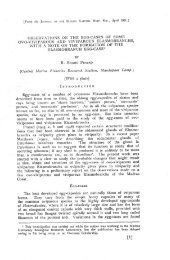PDF - Eprints@CMFRI
PDF - Eprints@CMFRI
PDF - Eprints@CMFRI
Create successful ePaper yourself
Turn your PDF publications into a flip-book with our unique Google optimized e-Paper software.
113<br />
addition: " Habite la mer Rouge". However, the type comes from the Seychelles (MAlTHAI 1914, pI. 23 ,<br />
fig . 4). After having reexamined the type CHEVALIER is convinced (197 1: 148 and 161), in accordance<br />
with ROSE (1968), that it is only Favia favus. Favia valenciennesi does not occur in the Red Sea.<br />
Genus Favites LINK, 1807<br />
T y pes pee i e s: Madrepora abdita EL LI S & SOLAND ER, 1786.<br />
G e n e ric c h a r ae t e r s : Encrusting to massive, sometimes the surface rising to hillocks and<br />
branches. Corallites cerioid , calices polygonal. Major septa of equal width at the thecal wall , often without<br />
developed paliform lobes . Asexual reproduction by mono- to tristomodaeal intratentacular budding,<br />
permanent condition monostomodaeal (but polycentric cond ition is found in F. bennettae VERON,<br />
PICHO & WljSMAN-BEST , 1977).<br />
Synopsis of Fa vites from Red Sea :<br />
1. Corallum submassive, hemispherical, surface level. Corall ites polygonal, wall acu te at the top. CoraJlites<br />
12 to 16 and up to 20 mm long and up to \0 mm deep. Septa very narrow with equidistant<br />
serration at the edges. Pali conspicuous o n major septa. . . . . . . . . . . . . . . . . . . . . . . . . . . . . F. peresi<br />
2. Corallum massive, hillocky. Corallites polygonal, \0 to 14 mm long and 7 to 10 mm broad, 4 to<br />
7 mm deep. Intercorallite wall thick (J to 2 mm). Calices rounded wi th up to 60 septa. One side of<br />
the corallites more elevated . Septal teeth well-formed . . ........... . ....... .. . .. .. . . F. abdita<br />
3. Corallum usually massive , sometimes encrusting or with hillocks. Corallites up to 20 mm long, 14 mm<br />
broad and 7 mm deep. Septa up to 50. Septal teeth secondarily frosted, giving a spiny look to the<br />
coral. Maj or septa exsert and often continuous over the wall. . .... . ............. F. complanata<br />
4 . Corallum massive or encrusting. Corallites 18 to 22 mm long, about 15 mm wide, 10 mm deep. Intercorallite<br />
wall 2 to 3 mm thick. Septa up to 75 , steeply descending, narrow at the wall. Paliform lobes<br />
absent. Septa unite at the top of the intercorallite wall. . . . . . . . . . . . . . . . . . . . . . . . . .. F. flexuosa<br />
5. Corallum encrusting or explanate. Corallites polygonal, 8 to 10 mm long, 6 to 8 mm broad, 4 to 5 mm<br />
deep. Calices oval or circular. Septa 28 to 40. Exsert parts of septa generally stop at the middle of<br />
the intercorallite wall with a groove. . .... .. .... . ............... . ........ . .... F. halicora<br />
6. Corallum massive, rounded. Corallites polygonal , wall thin and acute at the top. Corallites 5 to 8 mm<br />
in length , and about 3 to 4 mm deep. Septa 24 to 36 with feebly developed dentation. 0 paliform<br />
lobes. . . ... ....... . . . ........ . .. .. ... . . .. . . . . . . . . ................ . .. . F. acuticollis<br />
7. Corallum encrusting, massive or hillocky. Corallites polygonal,S to 8 mm long and wide , 3 to 5 mm<br />
deep. Wall thickened up to 2 mm with a median raised thin ridge. Calices polygonal, oval or rounded .<br />
Septa 24 to 36. Major septa with paliform lobes . . .... ... .. . .. . .... . .. .. ....... F. pentagona<br />
Favites<br />
peresi<br />
Favites peresi FAU RE and PI CHON, 1978<br />
(Plate 28, Figs. 4. 5)<br />
1978, FAURE & PI CHON, 107 ; pis. 1- 5 (Type locality; Madagascar) ,<br />
1980. HEAD. 151.457.<br />
The foolowing is a generalized description of the specimens we have examined. Corallum massive,<br />
hemispherical or expanding towards the top from a narrow base, in some cases the colonies are found<br />
unattached. An epitheca often visible at the underside. Corallites cerioid , polygonal, tetra- or pentagonal,<br />
12 to 16 mm long (in specimen NS 1325 they are 20 mm long and 10 mm deep), 8 to ~2 mm broad, 3 to<br />
8 mm deep. Wall acute at the summit, getting thicker towards the bottom. Septal number varies according<br />
to the size of the calices, for example a calyx 16 x 11 mm has a total of 55 septa and another 11 x 8 mm<br />
has 36 septa excluding a set of rudimentary ones. Septa close-set of equal width throughout the length,<br />
steeply descending, 14 to 18 septa meet the columell a. Two subsidiaries from either side generally turn<br />
towards the central major septum before the latter unites with the columella. At the point of fusio n of
















